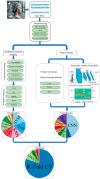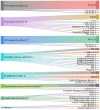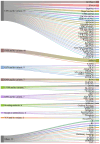Resting-State Electroencephalogram Depression Diagnosis Based on Traditional Machine Learning and Deep Learning: A Comparative Analysis
- PMID: 39517712
- PMCID: PMC11548331
- DOI: 10.3390/s24216815
Resting-State Electroencephalogram Depression Diagnosis Based on Traditional Machine Learning and Deep Learning: A Comparative Analysis
Abstract
The global prevalence of Major Depressive Disorder (MDD) is increasing at an alarming rate, underscoring the urgent need for timely and accurate diagnoses to facilitate effective interventions and treatments. Electroencephalography remains a widely used neuroimaging technique in psychiatry, due to its non-invasive nature and cost-effectiveness. With the rise of computational psychiatry, the integration of EEG with artificial intelligence has yielded remarkable results in diagnosing depression. This review offers a comparative analysis of two predominant methodologies in research: traditional machine learning and deep learning methods. Furthermore, this review addresses key challenges in current research and suggests potential solutions. These insights aim to enhance diagnostic accuracy for depression and also foster further development in the area of computational psychiatry.
Keywords: artificial intelligence; deep learning; major depressive disorder; resting-state electroencephalography; traditional machine learning.
Conflict of interest statement
The authors declare no conflicts of interest.
Figures







Similar articles
-
EEG based functional connectivity in resting and emotional states may identify major depressive disorder using machine learning.Clin Neurophysiol. 2024 Aug;164:130-137. doi: 10.1016/j.clinph.2024.05.017. Epub 2024 Jun 1. Clin Neurophysiol. 2024. PMID: 38870669
-
A data-centric and interpretable EEG framework for depression severity grading using SHAP-based insights.J Neuroeng Rehabil. 2025 May 25;22(1):116. doi: 10.1186/s12984-025-01645-5. J Neuroeng Rehabil. 2025. PMID: 40414904 Free PMC article.
-
Advances in EEG-based detection of Major Depressive Disorder using shallow and deep learning techniques: A systematic review.Comput Biol Med. 2025 Jun;192(Pt A):110154. doi: 10.1016/j.compbiomed.2025.110154. Epub 2025 Apr 23. Comput Biol Med. 2025. PMID: 40273818
-
Opportunities and Challenges for Clinical Practice in Detecting Depression Using EEG and Machine Learning.Sensors (Basel). 2025 Jan 12;25(2):409. doi: 10.3390/s25020409. Sensors (Basel). 2025. PMID: 39860780 Free PMC article.
-
Classification of Depression Through Resting-State Electroencephalogram as a Novel Practice in Psychiatry: Review.J Med Internet Res. 2020 Nov 3;22(11):e19548. doi: 10.2196/19548. J Med Internet Res. 2020. PMID: 33141088 Free PMC article. Review.
Cited by
-
Neural Correlates of Burnout Syndrome Based on Electroencephalography (EEG)-A Mechanistic Review and Discussion of Burnout Syndrome Cognitive Bias Theory.J Clin Med. 2025 Jul 29;14(15):5357. doi: 10.3390/jcm14155357. J Clin Med. 2025. PMID: 40806977 Free PMC article. Review.
-
Increasing the Construct Validity of Computational Phenotypes of Mental Illness Through Active Inference and Brain Imaging.Brain Sci. 2024 Dec 19;14(12):1278. doi: 10.3390/brainsci14121278. Brain Sci. 2024. PMID: 39766477 Free PMC article. Review.
References
-
- World Health Organization . Depression and Other Common Mental Disorders: Global Health Estimates. World Health Organization; Geneva, Switzerland: 2017.
Publication types
MeSH terms
Grants and funding
LinkOut - more resources
Full Text Sources

